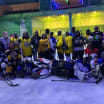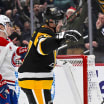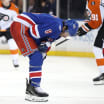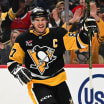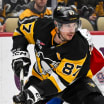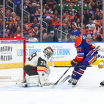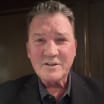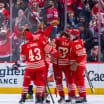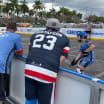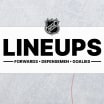Legendary hockey reporter and analyst Stan Fischler writes a weekly scrapbook for NHL.com. Fischler, known as "The Hockey Maven," shares his humor and insight with readers each Wednesday.
This week's edition is based on a series of interviews he conducted with New York Rangers Hall of Fame goalie Chuck Rayner. Fischler first interviewed the man nicknamed "Bonnie Prince Charlie" in 1951 and did additional one-on-ones with Rayner up to 1978.
Voices From The Past: Chuck Rayner
Hall of Fame goalie discusses winning Hart Trophy, near-miss in 1950 Cup Final
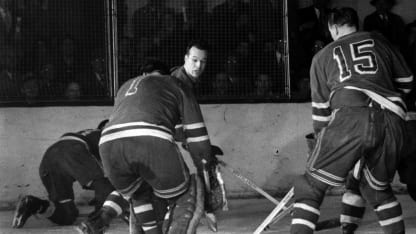
© B Bennett/Getty Images
By
Stan Fischler
Special to NHL.com
What do you remember about your earliest hockey successes?
"I started as a young goaltender in my home province, Saskatchewan, but it was in Ontario that I finally found my niche. In the 1937-38 season I joined the Kenora Thistles, a junior team. Despite Kenora being in Ontario, our team played in the Manitoba Junior Hockey League. I played 22 games that first year and didn't have a very good goals-against
-- but he got hurt and I was called to New York as his replacement. I played a dozen NHL games, and though I didn't do all that well when it came to winning and losing (2-7, three ties), I did get a feel for the big time. A year later I had replaced Robertson as the starter, but our team had a new name, the Brooklyn Americans."
How strange was that?
"Very strange. For one thing, we weren't playing in Brooklyn; the Americans were still sharing Madison Square Garden with the Rangers. But Dutton was tired of paying rent to the Garden; he wanted his own rink in Brooklyn. Red had big plans for a new arena in the downtown area of the borough, and to give us a feel for his hoped-for future home, we had 'Brooklyn' on the front of our jerseys throughout 1941-42. But we were not very good. Out of the seven NHL teams, we finished seventh (16-29, three ties), miles behind our rivals, the Rangers. They finished first with a fine young goalie, Sugar
Jim Henry
, who would become a good friend and, later, my teammate."
How did World War II affect you?
"By 1942, just about every NHL ream had its roster sliced by enlistments into the Canadian and U.S. armed forces. I joined the Royal Canadian Navy and was assigned to Victoria in British Columbia. There was a Navy team in Victoria just as there were service teams all over Canada and even overseas. Our Navy club played other service teams from British Columbia. For me, the most memorable one was a game we played against a Vancouver Army team. It meant a lot to me because I had always dreamed of what it would be like to actually score a goal -- as a goalie. That dream came true the night we played Vancouver Army. It came about after a rush by Army's
Bill Carse
who had played for the Chicago Blackhawks. Carse's shot bounced off my chest and toward the Vancouver goal. When I realized that all the skaters were bunched behind my net, I saw clear ice and said to myself, 'The heck with it, why not keep going?' With a jump on all the players behind me, I hustled over the blue line and -- no deke, no nothing -- just fired the puck past their goalie, Art Jones; fulfilling my goal-scoring dream."
How did you wind up with the Rangers after the war?
"The Americans disbanded during the war, and I became a free agent. Frank Boucher, who was running the Rangers at the time, signed me for the 1945-46 season. At the same time, Sugar Jim Henry got out of the Canadian Army and showed up at training camp when I did. Our battle for the first-string job ended in a draw since Boucher decided there was little to choose between us. Instead of sending one of us to the Rangers' AHL farm team, he kept me and Sugar Jim; that's how the NHL's two-goalie system was born."
How did Boucher manage two goalies?
"Many times he dressed both of us for a game, and that caused strange things to happen. Frank got the idea to alternate us every third, fourth or fifth shift during games. One of us would replace the other in the net on a regular basis through the contest. One night the craziest thing happened; only one pair of goalie gloves was available. When I headed for the bench, Jim came on the ice and we'd meet and exchange gloves. Fans who'd never seen this before were stunned."
When did you finally win the No. 1 job?
"Right from the start, in 1945, I played most of the games. In 1948, Boucher needed a goal-scorer, so he traded Sugar Jim to the Black Hawks for
Alex Kaleta
and
Emile Francis
. That gave me the Rangers job to keep and I kept it, except for injuries."
How challenging was goaltending in terms of injuries?
"We had no masks, and that meant danger. Once I got hit in the right jaw during a game in Chicago -- broke the jaw. Even though the jaw was broken, the next night I played again and this time I got hit in the left jaw. Didn't break it but, considering the pain, it might as well have been broken. Another time a screened shot hit me in the forehead. I was carried to the Garden infirmary. Since there was no backup in those days, I had 10 minutes to get stitched up, only this time it was a bad cut. Didn't matter; the ref, King Clancy, came over and said, 'Time's up, get out there!' What could I do? I desperately wanted to play so I grabbed a towel, wrapped it around my head like a turban and skated to my crease."
Didn't you once almost score a goal in an NHL game?
"It happened in New York at the Garden. We were playing the Toronto Maple Leafs, leading them by a goal late in the game. Toronto coach Hap Day pulled his goalie,
Turk Broda
, for an extra skater. All of a sudden, I found the puck on my stick and took a couple of strides toward the blue line and then fired at the empty net, but I missed by about two or three inches. Speaking of goalies on offense, Boucher also occasionally used me on the Rangers power play, but I'd only work from the blue line and never scored. That plan was dropped pretty quick."
What do you remember about your best season, 1949-50?
"We had a good coach in Lynn Patrick with a solid defense. I had my best goals-against average (2.62) and six shutouts that year because of guys like
Gus Kyle
,
Allan Stanley
,
Pat Egan
and
Frankie Eddolls
on the blue line. Up front there was plenty of talent; especially at center with excellent stickhandlers like
Edgar Laprade
-- he could rag the puck during penalty kills like nobody's business -- and
Don Raleigh
, who we called 'Bones,' since he was skinny as a rail."
How far did you get with that Rangers club?
"Although we finished fourth and made the playoffs, we were under .500 (28-31, 11 ties) and played a tough Montreal team in the first round. The Canadiens were loaded with stars like
Maurice Richard
and
Bill Durnan
. A key move was when Lynn Patrick had our defensive left wing
Pentti Lund
shadow Richard. Pentti wound as up one of our leading scorers while Richard scored one lousy goal. We beat Montreal in five games, which was quite an upset. That put us in the Cup Final against Detroit -- really, a David and Goliath matchup since the Wings finished more than 20 points ahead of us."
Plus, you had no home games in New York -- how come?
"In those days, the circus was the Garden's biggest money-maker. Once the elephants arrived in April, they took over the building and that was that. Of course it put us in a bind because we couldn't play a single game of the Cup Final on home ice. Finally, the League decided that if the series went a full seven games the Rangers could get two 'home' games at Maple Leaf Gardens in Toronto while the other five games would be played at the Olympia in Detroit. Considering that tilted schedule, the experts figured the Wings might sweep us."
What do you remember about that Final?
"We had a good chance to win the Cup when we were up three games to two. Bones Raleigh had won two games for us with overtime goals and in Game 6, which could have been the Cup-winner for us, we led but Detroit caught us and forced a Game 7. That one went to overtime, tied 3-3, and we came close to beating
Harry Lumley
in goal for Detroit in the first sudden death, but it wasn't to be. A little past the eight-minute mark of the second overtime there was a face-off in our end. Detroit's
George Gee
won the draw and passed to
Pete Babando
. I saw Pete's shot a split second too late, kicked at the puck and maybe got a piece but it went in and we went out. Close but no cigar!"
Despite playing for an under-.500 team, you won the Hart Trophy in 1950. How did that happen?
"I thanked our publicity man, Stan Saplin, for that. I didn't know it at the time but in the midst of the Cup Final, Stan did some heavy lobbying with reporters on my behalf until he managed to get the one vote that won it for me. Stan learned this on a day off while a bunch of us were in the hotel playing cards, Quietly, he walked into the card room, leaned over my shoulder and whispered in my ear, 'Charlie, you just won the Hart.' I couldn't believe my ears. At first, I thought he was joking, but it was true."
When did you decide to retire?
"I had had it during the 1952-53 season. I had damaged the cartilage in my knee; pulled it out of shape. The doctor told me to get it operated on, which I did, and it helped out for a while. Then the knee weakened to the point where I couldn't do the job anymore, After playing 20 games, I decided to retire. I knew the Rangers would be in good shape because they had a kid named
Gump Worsley
replacing me and he went on to win the
Calder Trophy
as rookie of the year."
Any final thoughts on your career?
"I loved New York and was very happy being a Ranger, no matter where we finished. Playing in the big city was a great part of my life and I'll never forget my wearing the Blueshirt. Considering how close we came to winning The Cup, I'm disappointed that we missed back in 1950. But looking back, I feel honored having won the Hart as well as making the Hall of Fame although I never played on a winning NHL team. Thinking about my hockey life makes me smile because the game was good to me. After all, I made it to the world's best league and got paid well doing something I liked best -- stopping pucks!"
